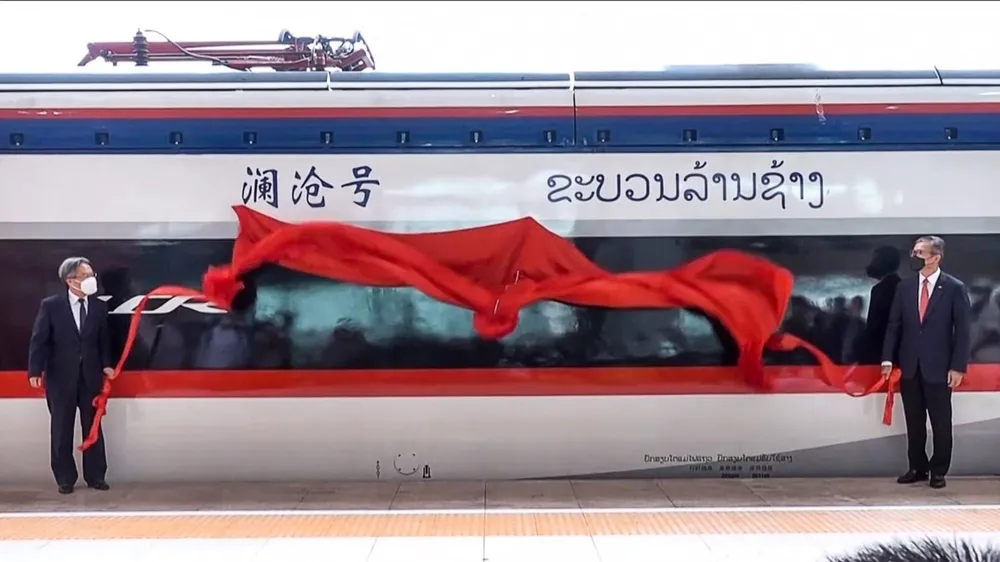
The high-speed rail link between the capital of Laos, Vientiane, and Kunming, the capital of Yunnan province in China, was officially inaugurated on December 3, 2021. In just one year (up to December 2022), this railway has transported goods worth 10 billion yuan, carried 2 million tons of cargo, and served nearly 1 million passengers. It has positioned Laos as a burgeoning commercial hub in the region.
Thailand has been the most effective beneficiary of this railway. Thailand's Ministry of Commerce reports a substantial surge in fruit exports to China since the Laos-China railway commenced operations at the end of 2021. Thai goods exported to China via this railway system are projected to reach USD 55 million in 2022, marking a more than 21-fold increase compared to 2021. In the first five months of 2023, Thailand's exports to China via this railway have exceeded USD 80.2 million, with fresh durian accounting for 72% of the total. This shift reflects Thai exporters' preference for bypassing Vietnam.
Before the pandemic, particularly in 2018, Thai exporters used to route their fruit through Vietnam, either by working with Vietnamese intermediaries or importing to Vietnam and subsequently exporting to China, generating nearly USD 600 million in revenue. However, since 2021, Thai exporters have largely abandoned this route in favor of the Laos-China railway. This decision has enabled them to cut delivery times to China to a mere 15 hours, a significant improvement over the previous two-day truck journey or the five-day route via Vietnam. Thailand's main fruit exports to China now include bananas, coconuts, durian, dragon fruit, and longan.
Predictions suggest that Thailand will export around 2.5 million tons of fresh fruit to China this year, equivalent to USD 5.5 billion, marking a USD 600 million increase compared to the previous year. Durian exports have reached record levels, with the country exporting 700,000 tons in 2022, 90% of which went to China. In the first five months of 2023, China imported 446,152 tons of durian from Thailand by train, a 58% increase compared to the same period in the previous year, amounting to over baht 2 billion (more than USD 57 million), up 364% compared to the same period in 2022.
The Laos-China railway stretches for 1,035 kilometers, constructed over five years (2016-2021) at a cost of USD 6 billion, with the Laotian segment covering 422 kilometers. The railway includes 198 kilometers of tunnels and 62 kilometers of river bridges and viaducts, boasting an average speed of 160 kilometers per hour. This rail link has propelled Laos' tourism industry forward, attracting more tourists than ever before.
According to Vientiane Times, in the first three months of 2023 alone, nearly 900,000 foreign tourists visited Vientiane, with 350,000 coming from Thailand, 180,000 from Vietnam, 145,000 from China, and 46,000 from Korea. Most of these tourists continued their journey to China via the high-speed train. Additionally, this railway has created job opportunities in local communities, particularly in service sectors, transformed the landscape, and unlocked the potential of previously underdeveloped areas in Laos.
Recognizing the advantages of rail transport for exports, the Thai government has devised plans to construct a high-speed railway linking Bangkok to Nong Khai, a city near the Lao border, in two phases. Phase 1, stretching from Bangkok to Nakhon Ratchasima City, spans 253 kilometers and commenced construction last year, with commercial operations expected in 2026. Phase 2, covering 355 kilometers from Nakhon Ratchasima to Nong Khai, will be completed in 2028. Once this project is realized, agricultural products from central Thailand can reach Chinese consumers via high-speed train in just 1-1.5 days.
Furthermore, Laos plans to extend the railway from Vientiane to the Thai border, spanning 34 kilometers, while China aims to integrate the Yunnan-Vientiane route into an international railway network connecting southern and southeastern Chinese provinces like Yunnan, Guangxi, and Sichuan with Laos, Bangkok (Thailand), Kuala Lumpur (Malaysia), and eventually Singapore. This ambitious 5,500-kilometer railway project is part of China's Belt and Road Initiative (BRI) being implemented in Southeast Asia.
This story highlights two significant points. Firstly, the slow pace of modernizing the North-South high-speed railway in Vietnam. The existing North-South railway, more than a century old, remains the world's oldest and most outdated transport route. Covering a distance of about 1,700 kilometers from Ho Chi Minh City to Hanoi, the journey takes approximately 35 hours, with an average speed of just 45 kilometers per hour. Vietnam had a golden opportunity to establish a modern North-South high-speed railway, extending to Lao Cai and connecting with Yunnan, China. Such a railway could have served as a pivotal transport route for goods and passengers, especially for the transportation of agricultural produce like fruits and seafood from the Mekong Delta to China.
Unfortunately, the current state of the railway has caused Vietnam to miss out on valuable opportunities for the development and export of agricultural products, potentially jeopardizing its market share in products such as coffee, cashews, pepper, rubber, and palm oil to China. The Ministry of Transport is currently preparing to submit a plan for a North-South high-speed railway to the Politburo, with a budget of USD 59 billion. Hopefully, this proposal will be accepted, and by 2035, Vietnamese citizens will have access to modern trains.
Secondly, the Laos-China high-speed railway story underscores China's capacity to engage in high-tech projects. However, it raises questions about why Vietnam has not, or cannot, tap into similar opportunities. One prime example is the Cát Linh - Hà Đông urban railway, which spans a mere 13 kilometers but cost nearly USD 1 billion and took over a decade to complete.




















